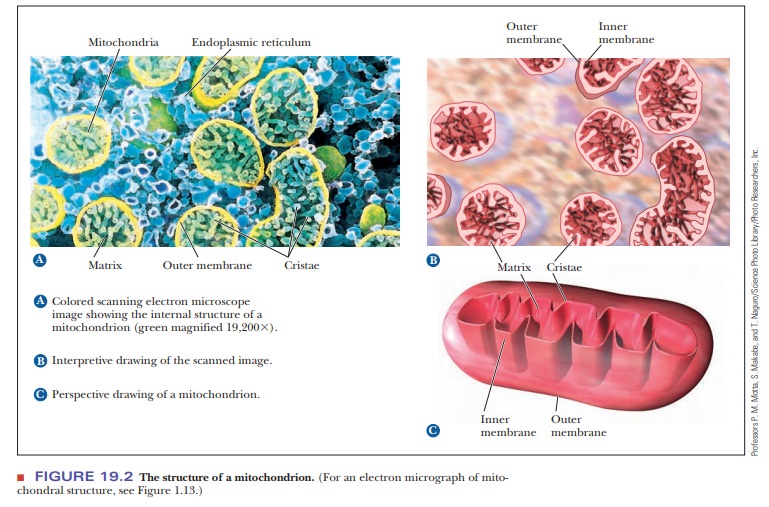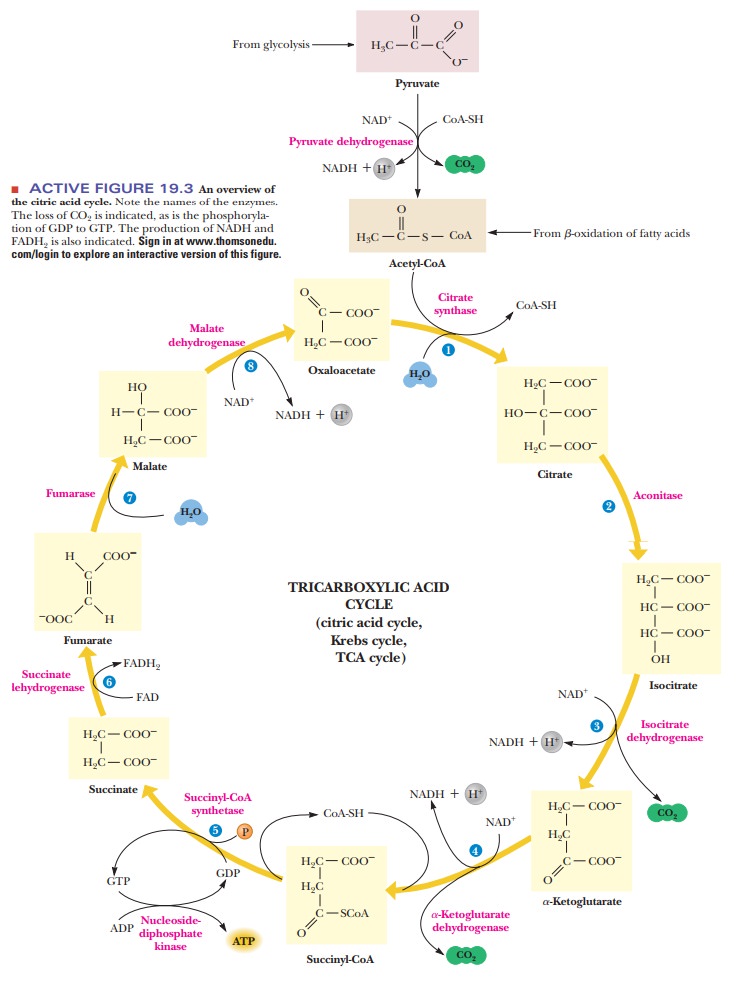Chapter: Biochemistry: The Citric Acid Cycle
The Overall Pathway of the Citric Acid Cycle
The Overall Pathway of the Citric
Acid Cycle
An important difference between glycolysis and the citric acid
cycle is the part of the cell in which these pathways occur. In eukaryotes,
glycolysis occurs in the cytosol, while the citric acid cycle takes place in
mitochondria. Most of the enzymes of the citric acid cycle are present in the
mitochondrial matrix.
Where does the citric acid cycle take place in the cell?
A quick review of some aspects of mitochondrial structure is in
order here because we shall want to describe the exact location of each of the
components of the citric acid cycle and the electron transport chain. Recall
that a mitochondrion has an inner and an outer membrane (Figure 19.2). The
region enclosed by the inner membrane is called the mitochondrial matrix, and an intermembrane
space exists between the inner and outer membranes. The inner membrane is a
tight barrier between the matrix and the cytosol, and very few compounds can
cross this barrier without a specific transport protein. The reactions of the
citric acid cycle take place in the matrix, except for the one in which the
intermediate electron acceptor is FAD. The enzyme that catalyzes the FAD-linked
reaction is an integral part of the inner mitochondrial membrane and is linked
directly to the electron transport chain.

What are the key features of the citric acid cycle?
The citric acid cycle is shown in schematic form in Figure 19.3. Under aerobic conditions, pyruvate produced by glycolysis is oxidized further, with carbon dioxide and water as the final products. First, the pyruvate is oxidized to one carbon dioxide molecule and to one acetyl group, which becomes linked to an intermediate, coenzyme A (CoA). The acetyl-CoA enters the citric acid cycle. In the citric acid cycle, two more molecules of carbon dioxide are produced for each molecule of acetyl-CoA that enters the cycle, and electrons are transferred in the process. The immediate electron acceptor in all cases but one is NAD which is reduced to NADH. In the one case in which there is another intermediate electron acceptor, FAD (flavin adenine dinucleotide), which is derived from riboflavin (vitamin B2), takes up two electrons and two hydrogen ions to produce FADH2.

The
electrons are passed from NADH and FADH2 through
several stages of an electron transport chain with a different redox reaction
at each step. The final electron acceptor is oxygen, with water as the product.
Note that, starting from pyruvate, a three-carbon compound, three carbons are
lost as CO2 via the production of acetyl-CoA and one turn of the cycle. The
cycle produces energy in the form of reduced electron equivalents (the NADH and
FADH2 that will enter the electron transport chain), but the carbon
skeletons are effectively lost. The cycle also produces one high-energy
compound directly, GTP (guanosine triphosphate).
In the first reaction of the cycle, the two-carbon acetyl group
condenses with the four-carbon oxaloacetate ion to produce the six-carbon
citrate ion. In the next few steps, the citrate isomerizes, and then it both
loses carbon dioxide and is oxidized. This process, called oxidative decarboxylation, produces the five-carbon compound α-ketoglutarate, which again
is oxidatively decarboxylated to produce the four-carbon compound succinate.
The cycle is completed by regeneration of oxaloacetate from succinate in
several steps. We shall see many of these intermediates again in other
pathways, especially α- ketoglutarate, which is very important in
amino acid and protein metabolism.
The citric acid cycle has eight steps, each catalyzed by a different enzyme. Four of the eight steps—Steps 3, 4, 6, and 8—are oxidation reactions (see Figure 19.3). The oxidizing agent is NAD+ in all except Step 6, in which FAD plays the same role. In Step 5, a molecule of GDP (guanosine diphosphate) is phosphorylated to produce GTP. This reaction is equivalent to the production of ATP because the phosphate group is easily transferred to ADP, producing GDP and ATP.
Summary
The citric acid cycle takes place in the mitochondrial matrix, with
excep-tion that one enzyme is located in the inner mitochondrial membrane. The
closely related process of oxidative phosphorylation takes place in the inner
mitochondrial membrane.
Related Topics